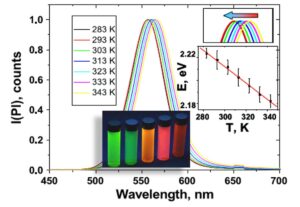2023 vol 2 issue 2
Review
N. Doskaliuk, Y. Lukan, Y. Khalavka
Pages 93-111
https://doi.org/10.58332/scirad2023v2i2a01
 Abstract
Abstract
Quantum dots are three-dimensional nanoparticles of semiconductors with typical sizes ranging from 2 to 10 nm. Due to the quantum confinement effect the energy gap increase with the size decreasing resulting in size-depended and fine-tunable optical characteristics. Besides this, the energy structure of a quantum dot with a certain size is highly sensitive to environmental conditions. These specific properties open a wide range of applications starting from optical and optoelectronic devices and ending with biosensing and life science. Temperature is one of those parameters influencing strongly on the optical properties of semiconductor nanocrystals, which make them promising materials for temperature sensing, more often using a fluorescent response. Compared to the conventional organic dyes already applied in this field, quantum dots exhibit a set of advantages, such as high quantum yield and photostability, long fluorescence lifetime, higher Stokes shift, and ability to surface functionalization with targeted organic molecules aimed to provide them biocompatibility. In this review, we briefly discuss the properties of II-VI and assumingly less toxic I-III-VI quantum dots, mechanisms of temperature-induced fluorescence response, and the feasibility of their practical application in the field of thermal sensing.
Keywords
quantum dots, photoluminescence, thermal sensing, temperature sensitivity, II-VI semiconductors, I-III-VI semiconductors, CdTe, CdS, PbS, AgInS2, CuInS2
First published: 19.04.2023